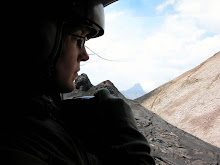Rice harvest in Quebrada Mina:When I think of Miguel Mora, I think "aqueduct," but when his wife invited me to help with the rice harvest, I got a new view of the committee member.

The grandmother stayed behind, she was already busy "toasting" yesterday's rice and the younger children kept her company - I think the worker crews are also determined by how many tools there are. Harvesting rice is one of the few jobs that doesn't rely on a machete - we needed special "cutters." These are really just wooden dowels with a rubber band and a box-cutter blade, and they're perfectly designed for the work.

We hiked up into the
campo to get to the field - halfway along the trail to get to the promising water tank area, ah-ha!
The rice was planted along the steep hillside that faced south, toward the Pacific coast, offering a lovely view as we began to work. Every few paces, I bumped into a stalk of corn, just about ready to be harvested as well. Higher
upslope the corn crop was more densely planted,
hmm... I think Miguel has been working with planting strategies.
We began the work fairly late, it was 10:00am when we took positions in the field. Even after helping
Joselina and
Ovidia, I still can't determine the work pattern. I've asked everybody, "should I work to the left, to the right, or straight uphill?" and the answer is always the same: "Wherever! Just collect what you see!" And then I try to respond with: "But aren't you continuing to the right, so I should continue up that way, you have a row and I have a row?"

These conversations always end with
armwaving - waving "
qualquier dirección." Okay, I'll just work where there's work to be done.
I
decided to take what photos I could immediately, Miguel had already asked if I would "document" our work and I joked back that yes, I would collect evidence that the rice was harvested on this day.
So I've posted our cameos - the timing was well-chosen, just 2 hours after we began the work, the graying skies brought us a wall of rain.

I think at least a solid day (a dry day) would have been necessary to finish the work. But next to the budding corn at the top of the hill, blue-tinted rice was also in view and continuing over the shoulder of the "
lomas" - Miguel's family has been busy this season!
Rice is hand-cut from the fields, grained, poured into a large cauldron "
pila" and toasted, cooled, pounded in a large mortar with an oak (guacha pali) pestle, then sifted on a platter. Only after all of those steps do you get to boil water and cook up the "
arroz nuevo" and I agree with my neighbors, it is so much tastier than the stuff sold in stores.
Is the concrete slab safe?
This was a question sticking in my mind after we poured the concrete. Now, after the seat was pulled from the mold and sealed to the floor, I feel better: I think we did a fine job.
This was also great timing. The church is planning a huge, fiesta-like event and will christen (so to speak) the new structure in a matter of weeks. The time is going fast and I expect the directive of the Adventist Church of Calabazal will attach planks and "penca" to finish the outhouse within the week.




























 What an engineering snafu:
What an engineering snafu: We had a significant donation of rebar for the project but unfortunately, the pit was dug so wide that most of the bars couldn´t cross the gap, for this reason, we decided to criss- cross and use a ton of wire to connect this web together.
We had a significant donation of rebar for the project but unfortunately, the pit was dug so wide that most of the bars couldn´t cross the gap, for this reason, we decided to criss- cross and use a ton of wire to connect this web together.

 Once the penca was ready, we were just about listo to start on my roof when, de repente hay lluvia: rain began to fall. It only lasted a few minutes but it was enough to cause Román some worry, so we adjusted the work plan. Today we will only fix the roof´s peak, the other gaps in
Once the penca was ready, we were just about listo to start on my roof when, de repente hay lluvia: rain began to fall. It only lasted a few minutes but it was enough to cause Román some worry, so we adjusted the work plan. Today we will only fix the roof´s peak, the other gaps in 























